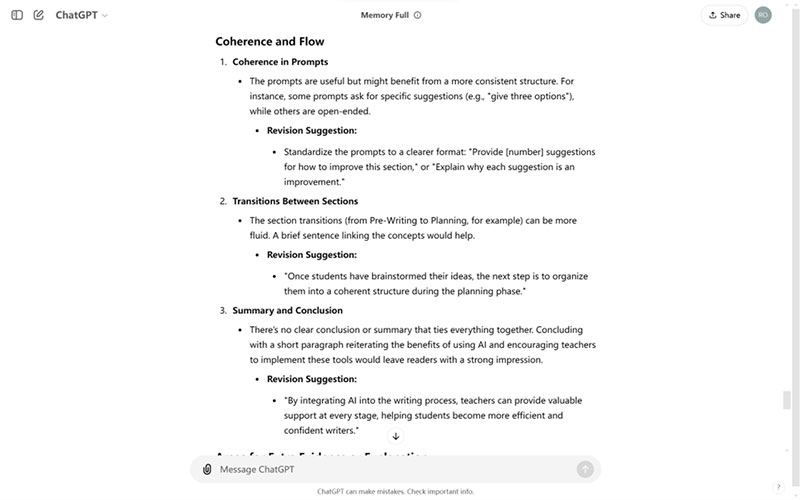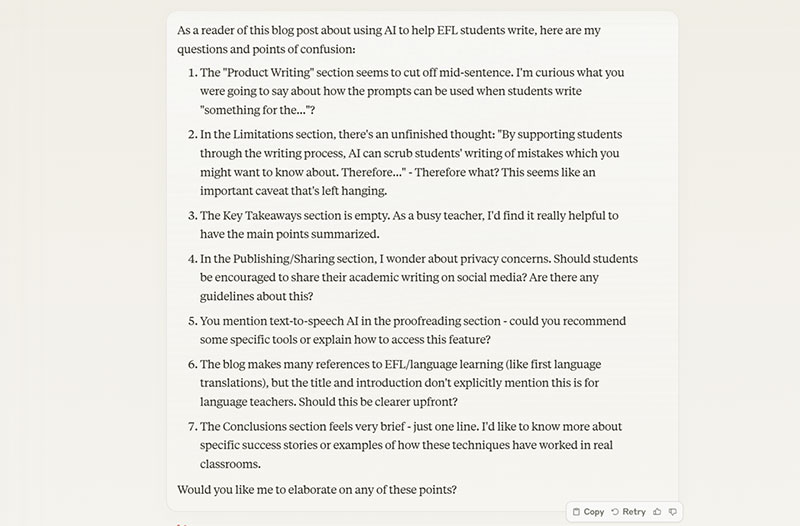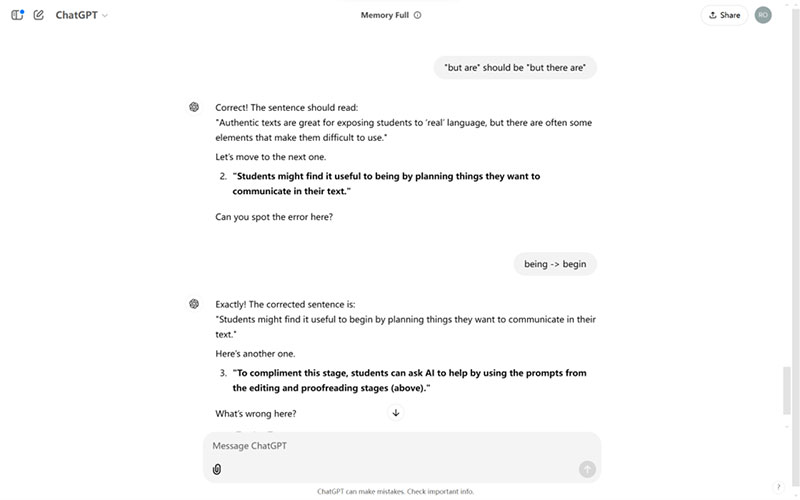18th December 2024
Writing is difficult. While almost everyone learns to listen and speak in their first language, not everyone learns to write. Until relatively recently, being able to write was the exception rather than the norm. And even now, being able to write is not the same as being able to write well.
The challenge of teaching writing has become even more complex with AI. Many teachers see it as a threat. If AI can write essays for students, how will they ever learn? But this argument misses something crucial. Writing has always involved learning from others, whether through reading great authors, getting feedback from teachers, or yes, sometimes copying from peers. AI is simply the newest tool in this tradition.
Without direction, students are no more likely to learn how to use AI than they are to learn English by sleeping with a dictionary under their pillow. But when used thoughtfully, AI can transform how students learn to write. It can guide them through brainstorming, help them find mistakes, and turn errors into learning opportunities. Using it thoughtfully takes guidance and it’s the teacher’s role to provide that guidance.
In this post we will look at how AI can help students learn to write. We will first look at using AI in the product approach to teaching writing. This is where students look at an example of a piece of writing, analyse it, then imitate it, changing the details to make it their own. Then we will look at the process approach to teaching writing. This is where students work through the writing process, from pre-writing to publishing. We'll close by examining the limitations of using AI to teach writing.
Product Writing
In product writing, students look at an example of writing and then create their own text in the same style.
This approach is helpful in three main situations:
- When teaching clearly structured writing formats (like job application cover letters, recipes, or college admission essays).
- When you only have a short time to teach writing (like a one-hour class).
- With students who are still learning a language and need extra support.
Product writing teaches students by providing a clear example of how to write a specific type of text. Students analyse the structure and features of a well-written example. They then create their own version using that model.
Next, we'll look at how AI can help teachers plan writing lessons and support students while they write.
Selecting a text
Product writing starts with students analysing an example text. AI can help you choose a text, or it can write a text for this purpose. Tell it the aim of the class, the genre of writing and the level of the students. It should create a text that your students can analyse.
Prompt: Write a [genre of text, e.g. letter of complaint] text. Use [CEFR] level English. Word count = [range] words. This text will be used by English language learners as a model text to learn how to write in this genre.
Instead of creating a new text, you might want to use an authentic text. An authentic text is just a text that was written without your (or anybody else’s) students in mind. You may have a few example texts and be unsure which would be the best model for your students. AI can help you choose.
Prompt: Help me to analyse the following texts for their suitability as a possible model text for an English writing class for [CEFR] level learners. Tell me the advantages and disadvantages of using the different texts. You may make a recommendation for which would be best, if appropriate. Possible model texts: ### Text 1: [text] ### Text 2: [text] ### Text 3: [text]
Authentic texts are great for exposing students to ‘real’ language, but often include some elements that make them difficult to use. AI can rewrite an authentic text, changing the problematic parts while keeping the best parts.
Prompt: Help me to rewrite the following text to make it a possible model text for an English writing class for [CEFR] level learners. After rewriting, include a short report of which parts were changed and why. Model text: ### [authentic text]
The report on which parts were rewritten can allow you to make informed decisions about what parts of the rewritten version to keep, and which to change back to the original.
Identifying key features
Now you have a model text. What features do you expect students to find in the text? AI can help identify key features (such as structure, tone, and language use) in a text. Refer to the AI analysis during your lesson to make sure you and the students don’t overlook any important features of the text. You can then guide students to find these features, which they will use later in the lesson in their own writing.
Prompt: Identify the key features of this model text, such as structure, tone, and language use. Give your analysis in clear simple English. Model text: [text]
Vocabulary
After analysing a text, students will start preparing to write their own. Students might find it useful to being by planning what they want to communicate when they write. After preparing a list of words and phrases they plan to use, students can ask AI for a vocabulary list. Learners can refer to this as they wrote.
Prompt: I am preparing to write a [type of text]. I plan to communicate the following: [main points]. Please suggest useful lexis (vocabulary and short phrases) for me to use. These should be at a [CEFR] level. For each item of lexis, include a translation into [students’ first language].
Students can be encouraged to choose some of these phrases and use these in their writing.
Feedback
Product writing classes often include a stage where learners get feedback from one another on their writing. To compliment this stage, students can ask AI to check their writing and give suggestions for improvement. We’ll look at more detailed feedback prompts in the section on Process Writing.
AI can also help students leave comments for their classmates in a way that encourages, while still being constructive.
Prompt: Please help to reword my feedback to my classmate. I want to sound supportive without being too critical. Please use simple English. My comments: [student feedback]
Should your students be in a position where they can’t get feedback from their peers, they can ask AI to act as a peer instead.
Prompt: Act as a classmate in an English language class. You need to give feedback to a peer in your class (me) on their writing. Use simple English. Writing: ### [text]
Final comparison
Once students have finished writing, AI can compare their text to the original model. It can give suggestions for improvement based on the example's structure and style.
Prompt: Compare my writing with the example text. Suggest [number] improvements based on how I could better follow the structure and style of the example. ### My writing: [students’ text] ### Example: [original text]
Process Writing
A process approach to teaching writing focuses on guiding students through the steps in the writing process. It works best with students who are more confident in their writing skills and don't need as much help from examples. This approach is great for genres of writing that don't have a strict format, like restaurant or movie reviews, travel stories, or opinion blogs.
Unlike product writing, which follows a tight structure, process writing lets students explore their ideas more freely. It takes more time to complete, but it's much closer to how people actually write in the real world. Students spend time thinking, planning, drafting, and improving their work - just like professionals do.
In this section, we'll explore how AI can help students at each stage of writing. We'll look at how technology can support writers as they move from having an idea to creating a finished piece of writing.
Topic
Before any writing starts, you’ll need to choose a topic for your learners to write about. (Few topics are harder than “Write about anything.”) If you’re at a loss for what to get students to write about, AI can give suggestions.
Prompt: I am planning a writing class for [CEFR] level English language learners. I want you to help me think of possible questions for them to answer or topics for them to write about. Ask me questions about one question at a time until you are able to suggest writing questions or topics.
Pre-Writing
At this stage, students explore the topic and gather their initial thoughts through activities like brainstorming, research, and mind mapping. They think about their audience and what they want to communicate.
One of the biggest challenges in pre-writing is generating and organising ideas. Many students struggle with where to start and how to generate enough relevant ideas. Students often benefit from a class discussion at this stage. If this is not practical, an AI text-generator can act as a conversation partner.
Prompt: I have to write an essay about [topic / question]. Please have a conversation with me about this topic to help me organise my thinking. Ask me questions related to this topic, one question at a time. Use simple English.
At the end of the conversation, AI can be asked to summarise the key points that have emerged from the discussion. Students can use these key points to help organise their writing.
Prompt: Please summarise the key points that emerged from our discussion into a format that can help me to start planning my essay. Use simple English.
Equally important is for students to understand what is expected of them. Students might get given a scoring rubric, but not have read it. AI can help students to analyse the rubric and understand what’s expected of them.
Prompt: Read this rubric. I will write an essay which will be graded using this rubric. Please highlight key points that I need to be aware of as I write. Explain in simple English. Rubric: ### [rubric]
Students could use the same rubric to generate feedback on their essay later in the writing process.
Once students are clear about what is expected of them and have brainstormed their ideas, the next step is to organise them into a coherent structure. This happens in the planning phase.
Planning
This is when students organise their ideas into an outline to guide their writing. At the planning stage, students map their main points and decide what evidence or examples they'll need to support their ideas.
Students might struggle to put their ideas in a logical order, covering the most important points. They may also struggle to decide where they need to expand on an idea or give evidence.
AI text-generators can analyse outlines and suggest how to improve structure and organisation. AI can find logical gaps, suggest transitions between sections, and recommend where to add evidence.
Prompt: Read the following outline of an essay. Comment on the order. Are there areas which would benefit from further examples? What gaps in logic can you identify? Make suggestions to improve the outline before I start writing. Use simple English. ### Outline: [student outline].
AI can also identify potential gaps in research or thinking, and suggest how to narrow or expand topics based on the scope.
Prompt: Read the scope below for a writing assignment. Compare this to my notes on the topic. Then suggest how to narrow or expand topics based on the scope. Scope: ### [writing question and/or criteria] ### [student outline].
If students are really stuck, they can ask for suggestions in organising their ideas. This support helps students overcome procrastination and get started on the writing process. Asking for more than one way to organise the ideas encourages students to make decisions about their writing, rather than outsourcing these to AI.
Prompt: Read my notes for answering an essay. Please suggest [number] ways that I could organise these coherently. Notes: ### [students’ notes] ### Essay question: ### [question, rubric, or scope]
After students have their ideas in a logical order, they can begin to draft.
Drafting
Drafting is when students write their first version of the text, getting their ideas down without worrying about perfection. This is probably the part of the writing process where AI is the least useful. The major challenge in drafting is maintaining momentum – writing without stopping. Students often get stuck trying to perfect each sentence as they write. This disrupts their flow and can lead to writer's block.
When writers’ block strikes, AI can expand on ideas. An AI text generator can suggest ways to elaborate or give a relevant example.
Prompt: Read the following paragraph from an essay about [topic]. Give [number] suggestions for how to continue this paragraph. Paragraph: ### [student’s writing]
After students have completed a draft, they can begin to revise their work.
Revising
This is when students look at their writing with fresh eyes and make big-picture improvements to content, organisation, and clarity. Students might move paragraphs around, add new information, or remove parts that don't fit.
A key challenge in revision is being objective about your own work. Students often struggle to see their writing from a reader's perspective. Students can often benefit from peer feedback at this stage. But in the absence of peers, AI can analyse writing for coherence, flow, and structure. Areas where arguments might be weak or unclear can be identified. AI can also suggest where extra evidence would be helpful, and highlight sections that might need reorganisation.
Prompt: Help me to revise my writing. The aim of this writing is to [aim of essay]. Analyse for coherence, flow, and structure. Identify areas where arguments might be weak or unclear. Suggest where extra evidence would be helpful. Highlight sections that could be better organised. Writing: ### [student’s writing]

Alternatively, AI can act as a reader, and give comments about their reaction to the writing. This might be more similar to the type of feedback students would get from a classmate.
Prompt: I want you to act as a reader. Read my writing. The context for this writing is [context]. Tell me what questions you would have after reading this, or what you might be confused about. Write your comments in simple English. Writing: ### [student’s writing]

Once students have made big-picture changes to their writing, they can start editing.
Editing
This is when students fine-tune their writing by improving word choice, fixing grammar issues, and making sure their style is consistent. Editing is particularly challenging for students, as they need to focus on multiple areas at the same time. This multitasking can feel overwhelming. To solve this, students can ask AI to help them analyse one area at a time.
AI can analyse writing for consistent tone, style, and vocabulary level. AI can also help students balance sentence variety, check for appropriate transitions, and maintain consistent terminology, while preserving the student's voice.
Prompt: Please help me in the editing process of my essay. I want you to read my essay and focus on the vocabulary used. Please highlight any times in the essay:
- Where the tone is inconsistent.
- Where a word or phrase is overused.
- Where there is a more precise or nuanced word that would work better.
- Where I have used a word or phrase inappropriately.
Students might also ask for help with transitions between specific sections. AI can analyse the logical flow between paragraphs and sections, helping students ensure their ideas progress naturally and their arguments build effectively.
Prompt: Analyse the logical flow between paragraphs and sections. Suggest ways to ensure that my ideas progress naturally and the arguments remain effective. Writing: ### [student’s writing]
Students can also go back to the structure and check that this matches the genre. The prompt below checks for the structure of an essay. Adapt this prompt based on the genre your students are working on.
Prompt: Please read my essay and comment on the structure. Look at the introduction. Check this introduces the topic and has a clear thesis statement. Look at the body paragraphs. Do these have clear topic sentences? Do these support the thesis logically? And look at the conclusion. Does this summarise the key points and tie up the argument? Give up to [number] suggestions for how I can improve each of these areas. Writing: ### [student’s writing]
AI can help students reword awkward phrases. You don’t want AI to rewrite an entire essay. By giving students options and explaining the improvements, students stay in control of the final product and learn how to make their writing clearer for next time.
Prompt: Help me to improve this sentence [sentence] from this paragraph [paragraph]. Provide [number] suggestions for how to improve this section. Explain why each suggestion is an improvement.
Students might also want to edit individual words. They might find they’ve repeated a word or phrase and are looking for an alternative. AI can help generate synonyms, antonyms, and alternative phrases.
Prompt: Help me to change the word “[word to be changed]” in the following paragraph. Suggest [number] alternative words or phrases. For each, explain in simple English why this might be a good choice. Paragraph: [student’s writing].
Proofreading
Proofreading is students’ last chance to find and fix small mistakes before turning in their work. These might include spelling errors, missing punctuation weird formatting or awkward sentences.
Why is proofreading tricky? When we read our own writing, our brains see what we meant to write, not what we actually wrote. This happens to everyone, especially when writing in a second language.
A great proofreading trick is reading out loud. When we hear what we wrote we can catch mistakes that our eyes might miss. Text-to-speech AI is an ideal tool for helping students with this. Here's why:
- Hearing your writing helps you notice weird-sounding phrases.
- Text-to-speech AI reads every word carefully, without rushing.
- Students can catch missing words or repeated phrases more easily.
Students can also ask an AI text-generator to find spelling mistakes, typos, grammar errors, or other errors in their writing and highlight these. This can help catch any mistakes that have crept into their writing.
Prompt: Read this and find any typographical errors, or errors in word choice or grammar. Highlight each error and tell me how to change each error. Writing: ### [students’ writing].
Some teachers might object to AI pointing out students’ errors during the writing process. However, much of the feedback that students get from teachers is about spelling and grammar. Getting this kind of feedback from AI merely brings correction forward in the writing process.
There are valid reasons why teachers may not want students to hand in a polished essay. Some teachers collect common mistakes from students and ask the whole class to correct these errors. AI can take this a step further, and turn students’ errors into a correction activity, guiding learners to correct errors. This might help them avoid making similar mistakes in the future. At the very least, this should encourage students to learn from their mistakes rather than AI correcting these on their behalf.
Prompt: Read my writing and find any grammatical or lexical errors. Show me these one by one. For each mistake, ask me to correct this myself. If I don’t get the answer right the first time, give me a clue. If I still can’t get it right, give me a multiple choice of how to fix the mistake. Writing: ### [students’ writing].

Teachers worried their students are too impatient for this type of feedback can ask their learners to send a screenshot of the correction process (like the one above).
Publishing/Sharing
This is when students prepare their final version and share it with their intended audience. This could mean turning it in to their teacher or sharing it with classmates. Students might also reflect on what they learned from the writing process.
Some students may be interested in publishing their written work on social media. AI could help in making suggestions for where the work could be published. Before sharing online, students need to be aware of what to share and what too keep private. (Personal essays and reflective pieces should probably stay private. Argumentative essays might be suitable for a wider audience.) Students should also learn how to remove any sensitive information from their writing before posting. AI could help in making suggestions for where the work could be published and how to tweak it before posting.
Prompt: Please read my writing. Suggest which types of social media this might be best suited to. Give suggestions for how I could adapt the writing for the platforms you suggest. For example, are there any identifying details or sensitive information that should be removed?
Limitations
AI can be a helpful tool for students learning to write, but it's not perfect. The more your students use AI, the more dependant on AI they’re likely to become. Too much AI means too little thinking. Students need to learn to treat AI more like a copy editor, and not like a ghost writer. Just like a human copy editor, AI can make mistakes. It might make suggestions that don't make sense, or are just bad. Regardless, it’s vital that students are responsible for their own writing. “AI told me to write that” is not an acceptable answer. There is also a danger that AI's helpful editing might remove valuable insights into students' learning needs. Teachers may want to collect both initial (pre-AI) drafts and final versions to learn more about their students’ writing challenges. Ultimately, AI should be viewed as a writing assistant that can guide and support. It should never replace, a student's own unique voice.
Conclusions
Bringing AI into the writing process is dangerous. At best, we might speed up the learning process with personalised suggestions and feedback. At worst, we could end up with a generation that can’t write a shopping list without the help of AI. Teachers will play a crucial role in deciding this outcome. If we focus our feedback solely on correcting mistakes, students are likely to use AI to dodge the hard work of learning. Left to their own devices, many students will rely on AI to transform “idk what to say lol” into professional prose. But if we can show students how to use AI responsibly, we can transform a potential plagiarism generator into a surprisingly effective sidekick for learning.
Key Takeaways
- Writing is challenging, and not everyone learns to write well. Just like learning to speak, writing takes practice and guidance. AI can now be a helpful tool in this learning process.
- When used thoughtfully, AI can help students brainstorm, spot mistakes, and turn errors into learning opportunities.
- Product writing involves students studying an example text and then creating their own in a similar style. AI can help teachers find good example texts, identify key features, and suggest vocabulary for different writing genres.
- Process writing focuses on the steps writers take from start to finish. AI can help students generate and organise ideas by acting like a conversation partner. Students can use AI to brainstorm topics, understand assignment requirements, and create initial essay outlines.
- Editing with AI involves improving word choice, checking grammar, and maintaining a consistent writing style. Students can get suggestions for better word usage, transitions, and overall language precision.
- Text-to-speech tools can help students 'hear their writing and catch errors they might miss.
- While AI is a powerful writing assistant, it has limitations. Students must not become too dependent on AI and should understand that it's a tool for support, not a replacement for their own thinking and creativity.



